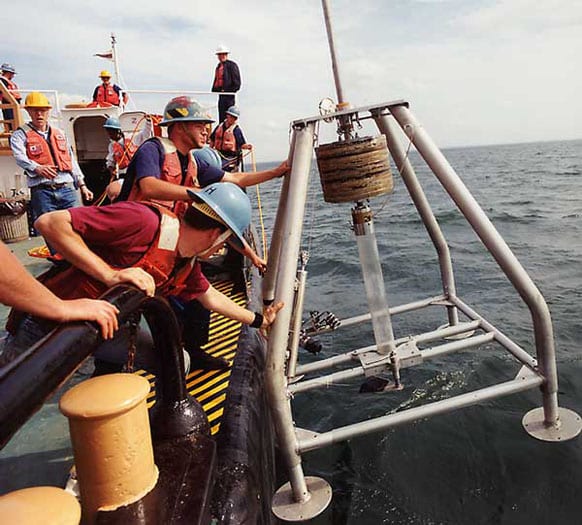Hydraulically Damped Gravity Corer
General Information
This instrument, like other corers and grab samplers, is used to sample sediments from the ocean floor. The unique aspect of this instrument is that it penetrates the sediment slowly in order to minimize disturbance of the water/sediment interface. The rate of penetration into the sediment is controlled by a water-filled piston that empties at a selectable rate. This feature allows collection without the bow wave that may occur when samplers approach the bottom swiftly. Cores up to 60 cm long are recovered in muddy sediments. Cores up to about 30 cm are collected in sand.
A hydraulically damped gravity corer is owned by Michael Bothner at USGS. If you wish to borrow it from the Coastal Ocean Institute (COI) instrument pool, please contact Michael (mbothner@usgs.gov).
History
Other sediment samplers, including the grab sampler and box corer, are still in use and take valuable samples. Although the box corer can collect even larger amounts of virtually undisturbed sediment, water and other fluids are effectively isolated. Therefore, the need exists in some cases to obtain "clean" samples of the water/sediment interface. A hydraulically damped gravity corer may be used to tackle this problem. As a result, sediment/water cores have been successfully taken from both muddy and sandy sediment, from the east coast Continental Shelf and from estuaries such as Boston Harbor and Long Island Sound.
How It Works
The hydraulically-damped gravity corer consists of a four-legged frame with a central sliding shaft that holds a heavy weight stand and a clear polycarbonate cylindrical core barrel. The apparatus is constructed of aluminum, plastic, and stainless steel in order to minimize heavy metal contamination of sediments.
The key feature that differentiates this corer is the hydraulic damping mechanism, consisting of a water filled piston that empties at a selectable rate as the corer penetrates the mud. When the corer contacts the ocean floor and releases tension on the winch wire, the water filled piston connected to the sliding shaft controls the speed that the core barrel enters the sediment. Typically, the core barrel takes 10 to 15 seconds to fill completely with sediment. As the core tube enters the sediment, a mechanical switch changes the sampling rate of a sonar transducer (optical sensor), providing a confirming signal on the ship's depth recorder. When this signal is received, the instrument is winched out of the sediment. A check valve seals the top of the core barrel. When the bottom of the core tube clears the water/sediment interface, a spring-loaded paddle slides against and seals the cutting edge of the core tube. Both sediment and ambient overlying water are captured by seals at the top and bottom of the core tube at the moment of pullout.
The core quality and sedimentary features can be observed by visual inspection through the clear core barrel. The core is then removed from the frame, capped and taped at both ends, then stored under refrigeration. To preserve the water/sediment interface, the core should be secured in a vertical position at all times. Overlying water is left to completely fill the head space above the water sediment for transport and storage. The cylinder can be safely transported by ship or car without resuspension or other disturbance.
Technical Information
Advantages:
- Samples both sediments and overlying water
- Minimal disturbance to water/sediment interface
- Can be used to sample metals and other inorganic material
- Metal barrels can be used for organic geochemistry studies compromised by the use of plastic
Disadvantages:
- Small sampling area and volume
- Not designed to sample living organisms
- More complex to operate
Manufacturers
Can be custom built by any machine shop capable of reading engineering drawings.
Typical Costs
Approximately $20,000
Deployment Gear/Constraints
- Heavy gauge wire/winch for deployment (corer weighs approx. 1/2 metric ton)
- Large boat size for transport
- Pre-deployment preparation of core tube.
Further Information
M.H. Bothner, P.W. Gill, W.S. Boothman, B.B. Taylor, and H.A. Karl. Chemical and Textural Characteristics of Sediments at an EPA Reference Site For Dredged Material on the Continental Slope SW of the Farallon Islands, U.S. Geological Survey Open-File Report No. 97-87.
M.H. Bothner, P.W. Gill, W.S. Boothman, B.B. Taylor, and H.A. Karl. Chemical Gradients in Sediment Cores from an EPA Reference Site off the Farallon Islands - Assessing Chemical Indicators of Dredged Material Disposal in the Deep Sea, U.S. Geological Survey, Marine Pollution Bulletin, Vol. 36, No. 6, pp. 443-457, 1998; Elsevier Science Ltd., Great Britain.
M.H. Bothner, M. Buchholts ten Brink and F.T. Manheim. Metal Concentrations in Surface Sediments of Boston Harbor - Changes with Time, U.S. Geological Survey, Marine Environmental Research, Vol. 45, No. 2, pp. 127-155, 1998; Elsevier Science Ltd., Great Britain.
Pictures and some descriptions provided by the United States Geological Survey (USGS), courtesy of Michael H. Bothner.

